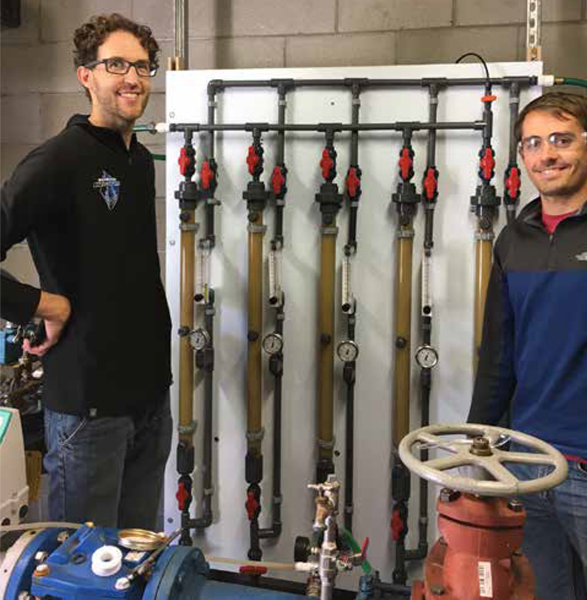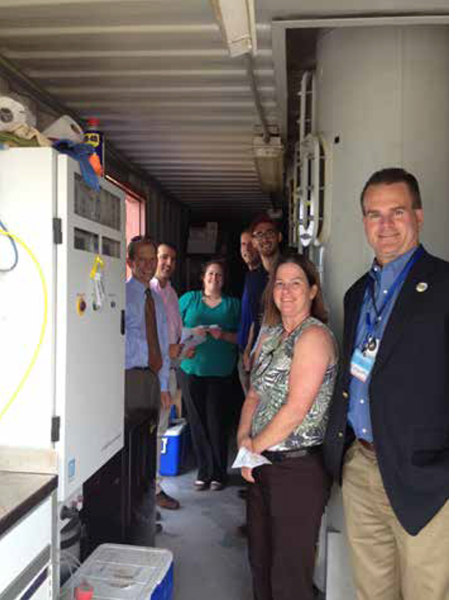- Reclamation
- News & Multimedia
- News Stories
- Stretching Water Supplies
Stretching Water Supplies
Written by: Collins Balcombe and Nathan Kuhnert, OTAO

Miguel Arias-Paic (left), and Anthony Kennedy, Reclamation Technical Service Center, commissioning an ion exhchange water treatment pilot unit to remove Chromium-6 from groundwater in Norman, Okla.
Reclamation is bringing expertise and funding to bear to help the city of Norman, Oklahoma be proactive in ensuring long-term reliability of local groundwater supplies by testing different technologies to treat hexavalent chromium (chromium-6). Norman's groundwater provides a critical supply alternative for the city and helps reduce pressure on the fully allocated surface water supplies provided by Reclamation's Lake Thunderbird, Norman Project. Results of the chromium-6 testing should help inform the design and optimization of full-scale treatment systems not only in Norman, but across the United States. The testing will also providing a model of how impaired water sources could be treated for beneficial uses to offset demands on Reclamation reservoirs and stretch existing supplies.
A team of Reclamation experts from the Technical Service Center's (TSC) Water Treatment Group was recently brought on by the Oklahoma-Texas Area Office (OTAO) to tackle this issue. The team; Miguel Arias-Paic (PI), Richard Huggins, Anthony Kennedy, Julie Korak have extensive knowledge and expertise in a wide array of treatment and waste minimization applications and field testing methods. The prior experience includes testing chromium-6 removal technologies in California.
In this case, Reclamation researchers are piloting strong base ion exchange and reduction/coagulation/filtration units that use resins and chemical reactions to either selectively remove or reduce chromium-6 to a trivalent form. The chemical reaction alternative creates a solid that is filtered out. The waste brine produced from strong base ion exchange uses membranes and other patent-pending technologies developed by Reclamation staff to minimize the waste. The units were designed by TSC and were field commissioned in October and November 2016. In addition, a third unit that uses microbes as a biological filter is being tested by Carollo Engineers, alongside Reclamation's units using cost-share funding provided by Norman and Reclamation.
Among the considerations in developing an effective pilot protocol, like any pilot project, are logistical constraints associated with optimization and scalability. Due to the distance between groundwater water wells throughout Norman, city officials will be comparing options of either installing satellite treatment units at individual groundwater wells versus piping the impaired groundwater to a centralized treatment location where various water sources could be blended to enhance economies of scale. Ultimately, pilot results will provide important information on chemical dosage, treatment efficiency, as well as waste generation, treatment, and disposal. Results are expected in the fall of 2017.
Chromium is a naturally occurring element found in rocks, animals, plants, soil and volcanic dust and gases, according to the National Toxicology Program. It comes in several forms, including what is commonly called chromium-3, an essential nutrient for the body. Chromium-6 can be found in nature, as in the case of Norman; but it also can be produced by industrial processes. The Environmental Protection Agancy (EPA) has established a drinking water standard of 100 parts per billion (ppb) for all forms making up Total Chromium, although it lacks a specific limit for chromium-6. This total limit was established in 1991 based on scientific information indicating that large quantities of chromium were toxic.
Chromium-6 on its own is particularly toxic and considered carcinogenic at high levels. Concerns have prompted the EPA to consider setting a national limit, which is currently under review and scheduled for completion in 2017. The state of California has already enacted a chromium-6 Maximum Contaminant Level (MCL) of 10 ppb for drinking water. Other states may follow with similar MCLs. In fact, a recent report showed that seven million Americans receive tap water with levels of chromium-6 that are higher than the legal limit established by California. Norman water users are among that group. Research shows that the annual costs for a national 10 ppb Chromium-6 standard would range from $0.55 billion to $5.1 billion per year, substantially higher than those for previous drinking water regulations.

OTAO staff join Reclamation’s TSC, Carolla Engineers, and the City of Norman to visit a biological treatment unit designed to remove Chromium-6.
Published on January 11, 2017

